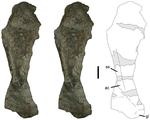| Popo Agie Formation | |
|---|---|
| Stratigraphic range: Late Triassic Carnian PreꞒ Ꞓ O S D C P T J K Pg N | |
| Type | Geological formation |
| Unit of | Chugwater Group |
| Overlies | Gartra Formation |
| Location | |
| Region | North America |
| Country | United States |
The Popo Agie Formation (/poʊˈpoʊʒə/ poh-POH-zhə) is a Triassic geologic formation that crops out in western Wyoming, western Colorado, and Utah. It was deposited during the Late Triassic in fluvial (river) and lacustrine (lake) environments that existed across much of what is now the American southwest. The earliest known dinosaur of the Laurasian continent, Ahvaytum, is discovered from the Popo Agie Formation. Dinosaurian trace fossils and fragmentary fossils of prehistoric reptiles and amphibians, including pseudosuchian reptiles and temnospondyl amphibians, have also been reported from this formation.
Paleobiota
Color key
|
Notes Uncertain or tentative taxa are in small text; |
Amphibians
| Taxon | Member | Material | Notes | Images |
|---|---|---|---|---|
|
Apachesaurus sp. |
Complete skull |
A metoposaurid temnospondyl; specimen from the Popo Agie Formation was originally described as Anaschisma sp. and later Eupelor browni |
||
|
Complete skull |
A metoposaurid temnospondyl. |
|||
|
Metoposauridae indet. |
Complete skull |
Specimen was originally described as Anaschisma browni |
Reptiles
| Taxon | Species | Member | Material | Notes | Images |
|---|---|---|---|---|---|
| A. bahndooiveche |
UWGM 1975, a left astragalus, and UWGM 7549, a partial left femur |
A probable sauropodomorph dinosaur and the oldest known Laurasian dinosaur |

| ||
| H. clarki |
UW 11562, a partial skull and postcranial skeleton; UW 11563 through UW 11565, partial postcranial remains; both from Big Horn Mountains, Wyoming |
||||
| B. cooowuse |
USNM 494329, a left maxilla and left dentary from Hole in the Wall, Wyoming; TxVP 46037.1, UWGM 7027 and UWGM 7028, maxillary fragments from Cottonwood Creek, Wyoming |
A rhynchosaur, previously assigned to cf. Hyperodapedon sanjuanensis |
|||
| P. gracilis |
UR 358, a partial ilium from Lander, Wyoming; UR 357, a partial skeleton including vertebrae, hips, and limb bones |
A bipedal poposauroid first described from the Popo Agie Formation and known from more complete specimens from the Chinle Formation |
|||
|
Sulcimentisauria indet. |
Indeterminate |
A partial left humerus and right femur |
A 'silesaurid' |
Synapsids
| Taxon | Member | Material | Notes | Images |
|---|---|---|---|---|
|
FMNH UC 633, a partial left scapula, left humerus, and left pelvis from Lander, Wyoming |
See also
Footnotes
- Locally "po-PO-zha" according to Don Pitcher, 2006, Moon Handbooks Wyoming, p. 269
- More ambiguous transcription of "po-po-zsha" at "Popo Agie Wilderness". The National Wilderness Preservation System. Wilderness.net. Retrieved 2008-03-08.
- High, L.R.; Hepp, D.M.; Clark, T.; Picard, M.D. (1969). "Stratigraphy of Popo Agie Formation (Late Triassic), Uinta Mountain Area, Utah and Colorado". Geologic Guidebook of the Uinta Mountains: Utah's Maverick Range (Sixteenth Annual Field Conference ed.). Utah Geological Association. pp. 181–192.
- ^ Lovelace, David M; Kufner, Aaron M; Fitch, Adam J; Curry Rogers, Kristina; Schmitz, Mark; Schwartz, Darin M; LeClair-Diaz, Amanda; St.Clair, Lynette; Mann, Joshua; Teran, Reba (2025-01-01). "Rethinking dinosaur origins: oldest known equatorial dinosaur-bearing assemblage (mid-late Carnian Popo Agie FM, Wyoming, USA)". Zoological Journal of the Linnean Society. 203 (1): zlae153. doi:10.1093/zoolinnean/zlae153. ISSN 0024-4082.
- ^ Sulej, T. (2002). "Species discrimination of the Late Triassic temnospondyl amphibian Metoposaurus diagnosticus" (PDF). Acta Palaeontologica Polonica. 47 (3): 535–546.
- Gee, B. M.; Jasinski, S. E. (2021). "Description of the metoposaurid Anaschisma browni from the New Oxford Formation of Pennsylvania". Journal of Paleontology. 95 (5): 1061–1078. Bibcode:2021JPal...95.1061G. doi:10.1017/jpa.2021.30. S2CID 235546289.
- Dawley, R.M.; Zawiskie, J.M.; Cosgriff, J.W. (1979). "A rauisuchid thecodont from the Upper Triassic Popo Agie Formation of Wyoming". Journal of Paleontology. 53 (6): 1428–1431.
- Fitch, A. J.; Haas, M.; C’Hair, W.; Ridgley, E.; Ridgley, B.; Oldman, D.; Reynolds, C.; Lovelace, D. M. (2023). "A New Rhynchosaur Taxon from the Popo Agie Formation, WY: Implications for a Northern Pangean Early-Late Triassic (Carnian) Fauna". Diversity. 15 (4): 544. doi:10.3390/d15040544. hdl:10919/114487.
- Lees, J.H. (1907). "The skull of Paleorhinus, a Wyoming phytosaur". The Journal of Geology. 15 (2): 121–151. Bibcode:1907JG.....15..121L. doi:10.1086/621382. JSTOR 30056366. S2CID 129850970.
- Mehl, M.G. (1915). "Poposaurus gracilis, a new reptile from the Triassic of Wyoming". The Journal of Geology. 23 (6): 516–522. Bibcode:1915JG.....23..516M. doi:10.1086/622268. JSTOR 30067173.
- Gauthier, J.A.; Nesbitt, S.J.; Schachner, E.R.; Bever, G.S.; Joyce, W.G. (2011). "The bipedal stem crocodilian Poposaurus gracilis: inferring function in fossils and innovation in archosaur locomotion" (PDF). Bulletin of the Peabody Museum of Natural History. 52 (1): 107–126. doi:10.3374/014.052.0102. S2CID 86687464. Archived from the original (PDF) on 2015-09-24.
- Kammerer, C. F.; Fröbisch, J. R.; Angielczyk, K. D. (2013). Farke, Andrew A (ed.). "On the Validity and Phylogenetic Position of Eubrachiosaurus browni, a Kannemeyeriiform Dicynodont (Anomodontia) from Triassic North America". PLOS ONE. 8 (5): e64203. Bibcode:2013PLoSO...864203K. doi:10.1371/journal.pone.0064203. PMC 3669350. PMID 23741307.
References
- Weishampel, David B.; Dodson, Peter; and Osmólska, Halszka (eds.): The Dinosauria, 2nd, Berkeley: University of California Press. 861 pp. ISBN 0-520-24209-2.
This article about a specific stratigraphic formation in the United States is a stub. You can help Misplaced Pages by expanding it. |




